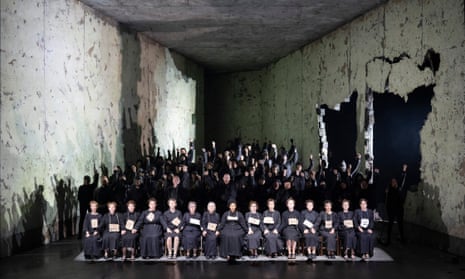Heavy, pained breathing. Voices of unseen figures, whispering. The brisk clicks of a potato peeler. It has taken almost 50 years for Poulenc’s doomed Carmelite nuns to reach Glyndebourne and their first appearance there, in a new production by Australian director Barrie Kosky, is full of noises. Some are beguiling, some mundane. Many overspill the limits of Poulenc’s score, creating unexpected moments of stasis between the opera’s rapidly cross-cut scenes.
These can be uncomfortable. In the most terrifyingly effective, the snips of scissors hacking at the nuns’ hair pre-empt the guillotine strokes of the ending. In the strangest, a garden slides on to the stage, rustling in from the peeling concrete walls of Katrin Lea Tag’s single, underpass-chic set. There are, perhaps, too many sluggish fade-outs for an opera with such inexorable momentum: Poulenc’s score sounds the steady tramp of a French Revolution that cannot be stopped, retaining the swift transitions of the screenplay that inspired it.
Those who associate Kosky with exuberant choreography or gorilla suits in Carmen may be surprised by the production’s visual spareness. The opening references to late 18th-century costume disappear once Blanche enters the convent; there the aesthetic is timeless frumpiness, the appliances modern, the potatoes real. The revolutionary mob wear denim, hoodies and riot helmets. After fleeing the convent, Blanche’s showdown with Marie, the nun designated as her protector, is unbearably naturalistic – and all the more upsetting – as an encounter between two women now clad in jeggings and anoraks. They fight, they weep, a saucepan is thrown in frustration.

Only the final scene, as the nuns go one by one to their deaths, threatens hyperbole. The amplified guillotine is jaw-achingly loud and each execution accompanied by a pair of shoes then fired across the stage. What haunts me is instead the tiny gesture of Blanche reaching for the hand of her fellow novice, Constance.
The power of such scenes is testament to the remarkable performances of the cast and ever-excellent Glyndebourne Chorus. Karen Cargill’s Mother Marie is vocally ferocious, Golda Schultz’s New Prioress her opposite – warm and almost girlish. Katarina Dalayman’s Old Prioress is utterly compelling, the seeming erotic undertones of her death truly disturbing, while Florie Valiquette’s Constance is sympathetic and crystal-toned. As Blanche, Sally Matthews convinces equally as wide-eyed aristocrat and religious martyr, her voice at times gritty with fury, elsewhere gleamingly beautiful.
Crucially, such intense vocal declamation is offset by cool orchestral detachment. From the neat energy of the opening, the London Philharmonic Orchestra is exquisitely controlled by Robin Ticciati, the onstage violence framed by woodwind solos of heartbreaking delicacy and juste-milieu sensuality from the strings. Only the periodic snarls of brass and percussion hint at aggression suppressed and this ultra-stylised opera’s firm grip on reality.

Comments (…)
Sign in or create your Guardian account to join the discussion